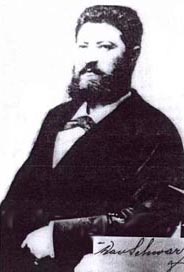
David Schwarz (aviation inventor)

David Schwarz | |
|---|---|
 | |
| Born | 20 December 1850 Keszthely, Kingdom of Hungary, Austrian Empire |
| Died | 13 January 1897 (aged 46) |
| Nationality | Hungarian |
| Occupation(s) | Inventor, business man |
| Spouse | Melanie |
| Children | Vera Schwarz |
David Schwarz (Hungarian: Schwarz Dávid; Croatian: David Švarc, pronounced [dǎʋit ʃʋârt͡s];[note 1] 20 December 1850 – 13 January 1897)[1][2] was a Hungarian aviation pioneer. He is known for creating an airship with a rigid envelope made entirely of metal.[2] Schwarz died only months before the airship was flown. Some sources[3] have claimed that Count Ferdinand Graf von Zeppelin purchased Schwarz's airship patent from his widow, a claim which has been disputed.[4] He was the father of the opera and operetta soprano Vera Schwarz (1888–1964).

Personal life
Schwarz was born in Keszthely,[dubious – discuss] Kingdom of Hungary, then part of the Austrian Empire[5][6] He was a timber merchant raised in Županja, but he spent most of his life in Zagreb, Kingdom of Croatia-Slavonia.[7][8] He was Jewish.[9]

Sources for his date of birth vary. The OCLC cites Rotem, Ẓ. giving it as 7 December 1850, while Brockhaus gives it as 20 December 1850[1] The OCLC, as well as Brockhaus, show Schwarz's place of birth as Zalaegerszeg, Hungary.[1]

Although Schwarz had no special technical training, he became interested in technology and developed improvements for woodcutting machinery.[citation needed]

First airship thoughts
Schwarz first became interested in airships during the 1880s. This occurred while working away from home supervising the felling of some forest land. As the work took longer than planned, he had his wife send him books to while away the evenings. These included a mechanics textbook. Although Schwarz became excited, it is not certain that this inspired him to build his own airship. His lumber business suffered due to his obsession and, like other aviation pioneers, his project attracted mockery. Nevertheless, his wife Melanie supported him. Schwarz proposed aluminium, then a very new material, for construction.

David s Having worked out the design of an all-metal airship, Schwarz then offered his ideas to the Austro-Hungarian war minister. Some interest was shown, but the government was not ready to pro vide financial support.

The Russian military attaché, a technically educated man, advised Schwarz to demonstrate his airship in St. Petersburg, where an airship using Schwarz's ideas was built in 1893.[10][11] Schwarz, and later his widow, assumed that test flights would also be made there, but this did not happen. He began construction in late 1892, with the industrialist Carl Berg supplying the aluminium and necessary funding.[12]

Problems arose during gas-filling: on inflation, the framework collapsed.[10] Schwarz apparently intended the metal skin to contain the gas directly without internal gas bags. The Russian engineer Kowanko pointed out that the lack of a ballonet would cause stresses on the skin during ascent and descent.[13] Also, the skin was not airtight,[14]

The first airship's specifications were:[13]

- Power: four cylinder engine weighing 298 kg (657 lb) producing 10 horsepower (7.5 kW) at 480 rpm
- Volume: 3,280 m3 (116,000 cu ft)
- Empty weight: 2,525 kg (5,567 lb)
- Gross lift: 958 kg (2,112 lb)
- Ballast and fuel: 170 kg (370 lb)
- Equipment and three people: 385 kg (849 lb)
- Net lift: 85 kg (187 lb)
The circumstances of Schwarz's return are unclear; there were reports of a hasty departure from Russia.[citation needed]

Second airship in Berlin
In 1894, Carl Berg procured a contract to build an airship for the Royal Prussian government, referring to Schwarz as the originator of the idea.[15][16] Berg already had experience working with the then novel aluminium, and was to later manufacture components for Zeppelin's first airship. With financial and technical help from Berg and his firm, the airship was designed and built.

Construction began in 1895 at the Tempelhof field in Berlin.[17] For a time the Prussian Airship Battalion placed its grounds and personnel at Schwarz's disposal.[18] The components were produced in Carl Berg's Eveking Westphalia factory and, under the direction of Schwarz, assembled in Berlin.[19] A gondola, also of aluminium, was fixed to the framework. Attached to the gondola was a 12 hp (8.9 kW) Daimler engine that drove aluminium propellers. One of the propellers was used to steer the craft.[10]

In June 1896 Carl Berg sent a card to his stepfather from Moscow apparently indicating that he had searched for information on Schwarz and became cynical of delays and was nearly convinced he had been swindled.[20]

Due to delays, the airship was first filled with gas and tested on 9 October 1896, but the results were not satisfactory because the hydrogen delivered by the Vereinigte Chemische Fabriken from Leopoldshall (part of Staßfurt) was not of the required purity and so did not provide enough lift. However, some sources claim that a test was performed on 8 October 1896.[21][22] It was determined that gas with a density of 1.15 kg per cubic metre was needed. Gas of that quality could not be obtained for some time, and a test flight could not be made until November 1897, roughly ten months after Schwarz's death.[23]

Death and maiden flight

Schwarz did not live to see his airship fly. Between 1892 and 1896 he traveled frequently, which affected his health. Shortly before his death he received news that his airship was ready to be filled with gas. On 13 January 1897 he collapsed outside the "Zur Linde" restaurant in Vienna, and died minutes later from heart failure, aged 44. Historical sources speak of a blutsturz (a term meaning either hemoptysis or hematemesis).[24]

David Schwarz was buried in Zentralfriedhof, Vienna.[25]

Carl Berg required confirmation of Schwarz's death, suspecting he had fled to sell his secrets. Nevertheless, Berg resumed the work with Melanie, Schwarz's widow, and together with the Airship Battalion they completed the airship with the addition of a gas relief valve.[26]

This second airship had these specifications:[27]

- Volume: 3,250 m3 (114,700 cu ft)
- Length: 47.55 m (156.0 ft)
- Diameter: 13.49 metres (44 feet 3 inches)
- Engine: 16 horsepower (12 kW) Daimler
- Four propellers: one of 2.6 metres (8 feet 6 inches) diameter between the gongal and the envelope, two of 2 metres (6 feet 7 inches) diameter mounted on brackets either side of the envelope, and a fourth of 2 metres (6 feet 7 inches) diameter revolving in the horizontal plane mounted below the gondola to drive the craft up or down.
- Envelope: 0.2 mm aluminium plates riveted to framework.
A later structural analysis based on the drawings concluded that it was defective, with the skin taking most of the shear stresses: distortions of the skin can be seen in a photo of the craft in flight.[28]

The second airship was tested with partial success at Tempelhof near Berlin, Germany, on 3 November 1897. Airship Battalion mechanic Ernst Jägels[29] climbed into the gondola and lifted off at 3 p.m. However, the airship broke free of the ground crew, and because it rose quickly Jägels disengaged the vertical axis 'lift' propeller. At an altitude of about 130 m (430 ft) the drive belt slipped off the left propeller, resulting in the ship "...[turning] broadside to the wind, [and with the result that] the forward tether broke free." As the ship rose to 510 m (1,670 ft) the drive belt slipped off the right propeller, the airship thus losing all propulsion. Jägels then opened the newly fitted gas release valve and landed safely, but the ship turned over and collapsed and was damaged beyond repair.[30]

Legacy
About the time of the trial flight and for decades after, various accounts, sometimes conflicting or misleading, were written of the events. Later, Berg, as well as his son, would write negatively of his experiences with Schwarz.

Some sources[3] state that Count Ferdinand von Zeppelin purchased Schwarz's patent from his widow in 1898, while others claim that the count used the design. However, Hugo Eckener, who worked with Count Zeppelin, dismissed these claims:

"Count Zeppelin negotiated with Herr Berg's firm for the purchase of the aluminium for his own ship. The firm, however, was under contract to supply aluminium for airships exclusively to the Schwarz undertaking. It had to obtain release from this contract by an arrangement with Schwarz' heirs before it could deliver aluminium to Count Zeppelin. That is the origin of the legend."[4]
Cvi Rotem (1903–1980) wrote the only known biography, titled David Schwarz: Tragödie des Erfinders. Zur Geschichte des Luftschiffes.[31] Rotem wrote that both Berg and Schwarz wished to keep their work secret.

From 3 December 2000 to 20 April 2001 the Museen der Stadt Lüdenscheid held an exhibition which covered Berg, Schwarz and Zeppelin history from 1892 to 1932, with displays of documents, photographs and airship remnants.[29][32][33]

Notes
References
- ^ a b c David Schwarz entry in the Virtual International Authority File, OCLC
- ^ a b Ernst Heinrich Hirschel, Horst Prem, Gero Madelung, Aeronautical Research in Germany: From Lilienthal until Today, "The Controllable Airship - The Dirigible", pp. 24-25. Springer-Verlag Berlin Heidelberg, 2004, ISBN 978-3-540-40645-7 (eBook ISBN 978-3-642-18484-0)
- ^ a b "Jewish Science and Technology Books: Personalities". Archived from the original on 17 January 2008. Retrieved 15 June 2008.
{{cite web}}: CS1 maint: bot: original URL status unknown (link) - ^ a b Hugo Eckener, Count Zeppelin: The Man and His Work, translated by Leigh Fanell, pages 155-157, 210-211. London – Massie Publishing Company, Ltd. – 1938 (ASIN: B00085KPWK) (online extract)
- ^ "13. siječnja 1897. Umro izumitelj David Schwarz". hrvatski-vojnik.hr (in Croatian). Hrvatski vojnik. Archived from the original on 23 July 2011.
- ^ "David Schwartz". hakave.org (in Croatian). Hrvatsko kulturno vijeće.
- ^ "David Schwarz". Državno povjerenstvo Republike Hrvatske (in Croatian). drzavno2012.pgsri.hr.
- ^ "DAVID SCHWARZ - nezasluženo u sjeni Zeppelina". hrvatski-vojnik.hr (in Croatian). Hrvatski vojnik. Archived from the original on 7 December 2014.
- ^ "Jewish Engineer, David Schwartz, Was Inventor of Zeppelin". Jewish Telegraphic Agency. 28 October 1924. Retrieved 15 September 2023.
- ^ a b c Whale 1995, Chapter II / Early airships and their development to the present day / Germany
- ^ he had started work at least by 2 May 1892 when Russian War Ministry agreed to allow him to build it there, after being rejected by the Austro-Hungarian War Ministry. Dooley 2004, A.183 citing Robinson 1984, p. 2
- ^ Dooley 2004, A.184, citing Robinson 1984, p. 1 and Berg 1926. Berg and Schwarz signed a contract 23 August 1893.
- ^ a b Dooley 2004, A.185.
- ^ Robinson 1973, pp. 6-7
- ^ Dooley 2004, A.186. Berg signed a contract with the Royal Prussian Government on 16 December 1894 with himself as the builder and Schwarz as the design source. Berg and Schwarz signed a contract on 21 December 1894.
- ^ Dooley 2004, A.186-A.187 Fig. 18. Battalion engineer Tenzer and Berg's engineers made drawings shown in Figure 18 titled Luftschiff David Schwarz das erste Luftschiff des starren Systems, erbaut von Commerzienrat Carl Berg.
- ^ Dooley 2004, A.187.
- ^ Dooley 2004, A.186, in the Prussian Airship Battalion's hangar.
- ^ Whale 1995; Dooley 2004, A.184. Accounts vary: George Whale wrote that the Berlin firm of Weisspfennig and Watzesch built it while Sean Dooley cites the U.S. airship historian Douglas Robinson as stating the work was done by Berg's engineers.
- ^ Eckhard Trox et al., 2000. "Objektliste.pdf exhibit list from now-stale Traum von Fliegen museum site" (PDF). Archived from the original on 2 September 2003. Retrieved 6 September 2017.
{{cite web}}: CS1 maint: bot: original URL status unknown (link) - ^ Sucur, Ante (2004). "The Airship of David Schwarz / The Construction and Testing of the Airship". Retrieved 19 October 2009.
- ^ rr0.org quoting Zagreb daily newspaper 'Obzor'
- ^ Mentschl Ch. p. 429 German: Ein erster Füllungsversuch im Herbst brachte allerdings ein unbefriedigendes Ergebnis, da sich das verwendete Wasserstoffgas als ungeeignet erwies. S. erlebte den Flug seiner Erfindung nicht mehr. Erst im November 1897 fand
- ^ Rosenkranz, Hans (1931). Ferdinand Graf von Zeppelin: die Geschichte eines Abenteuerlichen Lebens. Ullstein. p. 58.
- ^ Seifert, Karl-Dieter (2007). "Schwarz, David". Neue Deutsche Biographie 23. pp. 805–806. Retrieved 30 August 2016.
- ^ Dooley 2004, A.191.
- ^ Robinson 1973, p. 6
- ^ Dooley 2004, A.192.
- ^ a b Schnitzler writes that Jägels was a completely inexperienced airshipman, a former Prussian Unteroffizier.
- ^ Dooley 2004, A.193.
- ^ Dooley 2004, A.183.
- ^ Eckhard Trox 2000, Museen der Stadt Lüdenscheid German press release Archived 18 July 2011 at the Wayback Machine, and book: ISBN 978-3-929614-43-5
- ^ "extended from 4 March 2001". Archived from the original on 10 December 2002. Retrieved 16 June 2008.
{{cite web}}: CS1 maint: bot: original URL status unknown (link)
Bibliography
- Berg, Dr. Carl. (1926). David Schwarz - Carl Berg - Graf Zeppelin: Ein Beitrag zur Geschichte der Luftschiffahrt. Munich: Eigenverlag.
- Ch. Mentschl: "Schwarz David". In: Österreichisches Biographisches Lexikon 1815–1950 (ÖBL). Vol. 11, Austrian Academy of Sciences, Vienna 1999, ISBN 3-7001-2803-7, p. 429 f. (Direct links to "p. 429", "p. 430")
- Dooley, Sean C. (2004). "Part II: Appendices" (PDF). The Development of Material-Adapted Structural Form (PDF) (Thesis). École Polytechnique Fédérale de Lausanne. Archived from the original (PDF) on 25 June 2008.
- Robinson, Douglas H., Giants in the Sky. Henley-on Thames: Foulis, 1973 ISBN 0-85429-145-8
- Robinson, Douglas H. (March 1984). "Book Review 'Daivd [sic] Schwarz: Tragödie des Erfinders: Zur Geschichte des Luftschiffes. Von Cvi Rotem, Manuscript in limited edition, 1983". Buoyant Flight. Akron, Ohio USA: Lighter-Than-Air Society.
- Schnitzler, Norbert. 2000. WWW-Tipp der Woche 24/2000 (German summary of museum exhibition)
- Whale, George (1995). British Airships, Past – Present – Future. BiblioBazaar (published 26 October 2007). ISBN 1-4264-0074-8. (also 1996 Gutenberg version)
External links
- David Schwarz in the German National Library catalogue
- Library of Congress Linked Authority File for David Schwarz
- Sucur, Ante. "The Airship of David Schwarz". Retrieved 19 October 2009.
- Sucur, Ante (2008). "The Airship of David Schwarz / The Construction and Testing of the Airship". Archived from the original on 6 May 2008.
- Schwarz's Airship
See what we do next...
OR
By submitting your email or phone number, you're giving mschf permission to send you email and/or recurring marketing texts. Data rates may apply. Text stop to cancel, help for help.
Success: You're subscribed now !

